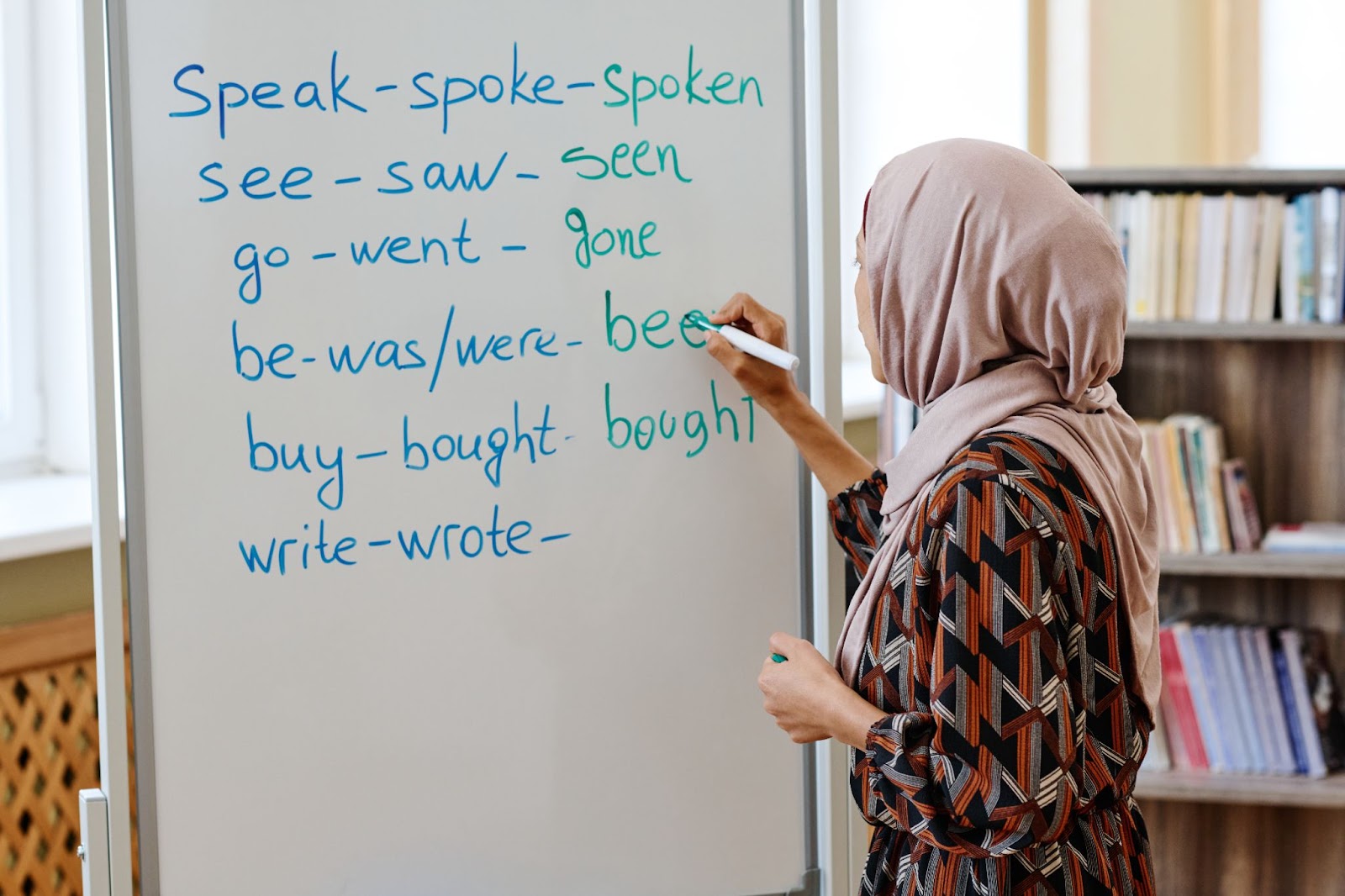
Spanish reflexive verbs are unique because they "reflect" the action back onto the person performing it. This indicates that the subject is the one who acts as well as the one who receives it. For example, "getting dressed" or "washing" may be reflexive if you're doing anything to yourself. Certain verbs in Spanish are reflexive by nature, whereas others only become reflexive in certain situations.
Since reflexive verbs are commonly employed in everyday conversations, such as when talking about routines, feelings, or personal care, Spanish language learners must master them. You may speak Spanish more smoothly and spontaneously if you know how to utilize these verbs correctly.
Key Tips Box
| Make Use of the Correct Pronoun: Consistently match the subject with the reflexive pronoun. "Tú" uses "te," "yo" uses "me," and so forth. Position Matters: The reflexive pronoun should normally come before the conjugated verb, with the exception of gerunds and infinitives, where it can come after. Context is crucial: ascertain whether the activity is aimed at the subject or another person. Use the reflexive form if it is self-directed, and the non-reflexive form otherwise. |

In Spanish, reflexive verbs are a specific type of verb that indicates that the subject is acting for themselves. This indicates that the subject is the one who acts as well as the one who receives it. For instance, when you say "Me visto" (I dress myself), you're clothing yourself.
The action is focused back onto the subject in reflexive verbs. Non-reflexive verbs, on the other hand, may be used to address someone or something else. For example, "Me lavo" (I wash myself) is reflexive since the action is carried out on the subject, whereas "Lavo el coche" (I wash the automobile) is non-reflexive.
The "-se" ending added to the verb's infinitive form is one way to recognize reflexive verbs in Spanish. The verb "levantar" becomes "levantarse" when it is reflexive, for instance. This conclusion shows that the subject is the object of the action.
The basic structure of a reflexive sentence in Spanish is: Subject + Reflexive Pronoun + Verb. Here's how it works:
Some common examples of reflexive verbs include:
In Spanish, there are five reflexive pronouns: me, te, se, nos, and os. These pronouns are used to indicate that the subject of the sentence is performing an action on themselves. Here's a breakdown of each pronoun and its corresponding subject:
| Subject Pronoun | Reflexive Pronoun | Reflexive Pronoun in English | Example |
| Yo | Me | Myself | Me visto (I dress myself) |
| Tú | Te | Yourself | Te lavas (You wash yourself) |
| Él, Ella, Usted | Se | Himself, Herself, Yourself | Se viste (He/She/You formal dresses themselves) |
| Nosotros, Nosotras | Nos | Ourselves | Nos levantamos (We get up) |
| Vosotros, Vosotras | Os | Yourselves | Os levantáis (You plural get up) |
| Ellos, Ellas, Ustedes | Se | Themselves, Yourselves | Se levantan (They/You plural formal get up) |
In contrast to other object pronouns, reflexive pronouns suggest that the subject is performing the action on themself. "Yo te veo" (I see you) employs the object pronoun "te," while "Yo me veo" (I see myself) utilizes the reflexive pronoun "me" to indicate that the action is directed back to the subject.
It's crucial that reflexive pronouns **agree with the subject** in number and person. This ensures clarity and grammatical correctness in sentences. For instance, "Yo me visto" (I dress myself) correctly matches the subject "yo" with the reflexive pronoun "me."
Here are some examples of incorrect sentences and their corrections:
| Incorrect | Correct | Explanation |
| Yo se visto (I dress myself). | Yo me visto (I dress myself). | The subject "yo" requires the reflexive pronoun "me," not "se." |
| Tú nos levantamos (You get up). | Tú te levantas (You get up). | The subject "tú" requires the reflexive pronoun "te," not "nos." |
| Nosotros se levantamos (We get up). | Nosotros nos levantamos (We get up). | The subject "nosotros" requires the reflexive pronoun "nos," not "se." |
When you use a verb without a reflexive pronoun in Spanish, the meaning of the sentence changes significantly. Here's how:
Non-Reflexive Verbs
Without a reflexive pronoun, the verb is non-reflexive, meaning the action is directed at someone or something else, not the subject themselves. For example:
In the non-reflexive form, the action of dressing is performed on someone else (my brother), not on the subject (I).
Change in Meaning
Some verbs change their meaning entirely when used reflexively versus non-reflexively. Here are some examples:

Conjugating reflexive verbs in Spanish involves a straightforward process that ensures you express self-directed actions clearly and correctly. Here's a step-by-step guide on how to conjugate reflexive verbs:
Here are some examples of conjugating reflexive verbs in the present tense:
| Subject | Levantarse (to get up) | Vestirse (to dress oneself) |
| Yo | Me levanto (I get up) | Me visto (I dress myself) |
| Tú | Te levantas (You get up) | Te vistes (You dress yourself) |
| Él/Ella/Usted | Se levanta (He/She/You formal gets up) | Se viste (He/She/You formal dresses themselves) |
| Nosotros (as) | Nos levantamos (We get up) | Nos vestimos (We dress ourselves) |
| Vosotros (as) | Os levantáis (You plural get up) | Os vestís (You plural dress yourselves) |
| Ellos/Ellas/Ustedes | Se levantan (They/You plural formal get up) | Se visten (They/You plural formal dress themselves) |
Reflexive verbs always finish in "-se" in their infinitive form. After this ending is removed during conjugation, the appropriate reflexive pronoun is added to denote the self-directed action.
For reflexive verbs, you simply add the reflexive pronoun before the conjugated verb. For example, "Me levanto" (I get up) or "Me visto" (I dress myself).
The infinitive form of reflexive verbs always ends in **"-se"**. In order to express the self-directed action, the proper reflexive pronoun is introduced after this ending is eliminated during conjugation.
Bañarse (to bathe oneself)
Despertarse (to wake up)
Cepillarse (to brush oneself)
| Subject | Bañarse (to bathe oneself) | Despertarse (to wake up) | Cepillarse (to brush oneself) |
| Yo | Me baño (I bathe myself) | Me despierto (I wake up) | Me cepillo (I brush myself) |
| Tú | Te bañas (You bathe yourself) | Te despiertas (You wake up) | Te cepillas (You brush yourself) |
| Él/Ella/Usted | Se baña (He/She/You formal bathes themselves) | Se despierta (He/She/You formal wakes up) | Se cepilla (He/She/You formal brushes themselves) |
| Nosotros (as) | Nos bañamos (We bathe ourselves) | Nos despertamos (We wake up) | Nos cepillamos (We brush ourselves) |
| Vosotros (as) | Os bañáis (You plural bathe yourselves) | Os despertáis (You plural wake up) | Os cepilláis (You plural brush yourselves) |
| Ellos/Ellas/Ustedes | Se bañan (They/You plural formal bathe themselves) | Se despiertan (They/You plural formal wake up) | Se cepillan (They/You plural formal brush themselves) |
In most cases, the reflexive pronoun is placed before the conjugated verb. For example:
When using infinitives or gerunds, the reflexive pronoun can be placed either before the infinitive or attached to the end of the infinitive or gerund.
Infinitives: The reflexive pronoun can be placed either before the infinitive or attached to the end of the infinitive. Here are correct examples:
Gerunds: The reflexive pronoun is typically attached to the end of the gerund. Here's a correct example:
When giving commands, the placement of reflexive pronouns differs between affirmative and negative commands.
Affirmative Commands: The reflexive pronoun is attached to the end of the verb. For example:
Negative Commands: The reflexive pronoun is placed before the verb. For example:
Here are more examples to illustrate the placement of reflexive pronouns:
| Before a Conjugated Verb | With an Infinitive | With a Gerund |
| "Me visto" (I dress myself). | "Quiero levantarme" (I want to get up) or "Quiero me levantar" (I want to get up). | "Estoy levantándome" (I am getting up) or "Estoy me levantando" (I am getting up). |
Putting the reflexive pronoun in the incorrect place is a frequent error, particularly when using gerunds and infinitives. Saying "Quiero me levantar" is fine, for example, although in many situations, it is more frequent and recommended to add the pronoun at the end ("Quiero levantarme").
Another error is completely omitting the reflexive pronoun, which alters the sentence's meaning. For instance, "Yo me visto" (I dress myself) denotes a self-directed action, while "Yo visto" (I dress) suggests clothing for someone else.

Spanish reflexive verbs can be divided into several categories based on their meaning and usage. Let’s see it!
Many Spanish verbs have both reflexive and non-reflexive forms, which differ in meaning based on whether the action is directed at the subject themselves or at someone/something else. Example:
Some verbs change their meaning significantly when used in their reflexive form. Here are some examples:
| Verb | Encontrar(se) | Levantar(se) | Volver(se) |
| Non-Reflexive | "Encuentro mi paraguas" (I find my umbrella). | "Levanto la alfombra" (I lift the rug). | "Vuelvo a casa" (I return home). |
| Reflexive | "Me encuentro cansado" (I feel tired). | "Me levanto" (I get up). | "Me vuelvo loco" (I am going crazy). |
These verbs are always reflexive and cannot be used without a reflexive pronoun. They include actions like taking care of oneself or curling up. Here are some examples:
Reciprocal verbs are used to describe actions that two or more people perform to each other. They are reflexive only in their plural forms and use the pronouns "nos," "os," and "se."
These verbs work similarly to other reflexive verbs in terms of pronoun placement but are limited to plural subjects.
Spanish reflexive verbs are frequently used in everyday conversation and are essential for describing self-directed actions. The following list of frequently used reflexive verbs is organized according to usage:
| Daily Routine Verbs | Emotional State Verbs | Movement and Position Verbs |
| Levantarse (to get up): "Me levanto temprano" (I get up early). | Sentirse (to feel): "Me siento feliz hoy" (I feel happy today). | Moverse (to move): "Me muevo rápidamente" (I move quickly). |
| Ducharse (to shower): "Me ducho todos los días" (I shower every day). | Enojarse (to get angry): "Me enojo fácilmente" (I get angry easily). | Acercarse (to get close to): "Nos acercamos a la puerta" (We get close to the door). |
| Vestirse (to get dressed): "Nos vestimos rápidamente" (We get dressed quickly). | Preocuparse (to worry): "Me preocupo por mis exámenes" (I worry about my exams). | Alejarse (to move away from): "Se aleja de la ciudad" (He/She moves away from the city). |
| Cepillarse los dientes (to brush one's teeth): "Me cepillo los dientes después de comer" (I brush my teeth after eating). | Alegrarse (to be glad): "Se alegra mucho cuando ve a sus amigos" (He/She is very glad when he/she sees his/her friends). | Caerse (to fall): "Me caí en la calle" (I fell on the street). |
Reflexive verbs are used frequently in everyday Spanish to describe self-directed actions. For example:

Depending on whether the action is performed on oneself or on someone or something else, one can choose between reflexive and non-reflexive forms in Spanish. Here are some recommendations and things to think about:
1. Actions Performed on Oneself: Use the reflexive form when the subject performs an action on themselves. For example:
2. Actions Performed on Others: Use the non-reflexive form when the action is directed at someone or something else. For example:
Sometimes the way actions are conceptualized in Spanish and English differs, which may affect whether a verb is employed reflexively. For example, "to shave" does not always indicate a reflexive action in English, whereas "afeitarse" in Spanish is reflexive since it refers to shaving oneself.
Verbs That Are Conceptualized Differently in Spanish
Some verbs have different reflexive and non-reflexive meanings in Spanish compared to English. For example:
Afeitarse (to shave oneself):
Arreglar(se):
To reinforce your understanding of when to use reflexive vs. non-reflexive forms, try these exercises:
1. Fill in the Blanks: Complete sentences with either the reflexive or non-reflexive form of the verb.
2. Translate Sentences: Translate English sentences into Spanish, choosing the correct form of the verb.
3. Create Sentences: Write your own sentences using both reflexive and non-reflexive forms of a verb.
Spanish reflexive verbs can be used in various tenses and moods, each with its own conjugation and usage rules. Here’s how reflexive verbs function across different tenses and moods:
| Tense | Explenation | Examples |
| Present | In the present tense, reflexive verbs are used to describe habitual or ongoing actions performed on oneself. | Me visto (I dress myself).Te lavas (You wash yourself).Se peina (He/She/You formal combs his/her/your hair). |
| Past - Preterite | Used for completed actions with a clear beginning and end. | Me vestí (I dressed myself).Te lavaste (You washed yourself). |
| Past - Imperfect | Used for ongoing or repeated actions in the past. | Me vestía (I used to dress myself).Te lavabas (You used to wash yourself). |
| Future | The future tense is used to describe actions that will occur in the future. | Me vestiré (I will dress myself).Te lavarás (You will wash yourself).Se peinará (He/She/You formal will comb his/her/your hair). |
| Command Forms (Imperative) - Affirmative Commands | Commands in Spanish are used to give instructions or orders. The reflexive pronoun is attached to the end of the verb. | Vístete (Dress yourself).Lávate (Wash yourself). |
| Command Forms (Imperative) - Negative Commands | The reflexive pronoun is placed before the verb. | No te vayas (Don't go).No te laves (Don't wash yourself). |
| Subjunctive Mood | The subjunctive mood is used to express doubt, uncertainty, or possibility. Reflexive verbs in the subjunctive mood are used to describe hypothetical or uncertain actions performed on oneself. | Espero que te laves (I hope you wash yourself).Es importante que se vista (It's important that he/she/you formal dress themselves). |
| Progressive Tenses | Progressive tenses describe ongoing actions. To form the progressive tense with reflexive verbs, use the verb "estar" in the appropriate tense, followed by the gerund form of the reflexive verb. | Present Progressive: "Estoy me lavando" (I am washing myself) or "Estoy lavándome" (I am washing myself).Past Progressive (Imperfect)**: "Estaba me lavando" (I was washing myself) or "Estaba lavándome" (I was washing myself). |
We have discussed the definition, conjugation, and usage of Spanish reflexive verbs in a variety of tenses and moods in this discussion. Here is a summary of the main ideas:
Mastering these concepts enhances your ability to communicate effectively in Spanish. Take your Spanish skills to the next level and make every conversation count!